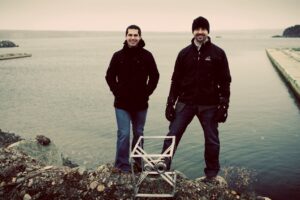For many, the only glimpse they will ever have of the RMS Titanic is what they see in the movies, documentaries or museums.
But there is now another way to get a close up view of this historical passenger ocean liner that sank in the north Atlantic Ocean in April 1912, and it’s made right here in Newfoundland and Labrador. Perhaps fitting as the ship collided with an iceberg and sank 600-kms south of the island.

SubC Imaging is a Clareville-based joint venture of Chad Collett, Chief Technology Officer (CTO), and Adam Rowe, Vice President and Co-Owner. Both are CNA alumni and the company has reached great depths since its start eight years ago.
Ron Collier, Vice-President, Business Development at SubC, says, “Primarily we will be providing the camera sensors for the submersible. We will be managing everything from image acquisition to recording and over-laying of the video. The video gets recorded and overlaid with other sensor data it could be depth or any other data parameters. Then when the video returns to the surface, in some cases, it will be 4K, and in some cases it will be high definition still images which could be used to create very accurate 3D models of the site.”
The two cameras (a 1Cam Mk6, and the brand new Rayfin that was designed completely in-house) to be used for the expedition to the Titanic shipwreck will be part of a partnership with U.S.-based OceanGate Inc. The cameras will be installed on a five-person submersible, and will record high-definition videos and pictures that will be used to build a 3D model of the ship.
The 3D model will further help serve as an objective baseline to assess the decay of the wreck over time, and help to document and preserve its submerged history. Following the expedition, images and videos of the wreck will be made freely available for research and education.
“The partnership between OceanGate and SubC for the Titanic trip helps motivate us and strive continuously to innovate the most technologically advanced and capable video equipment for the offshore and subsea markets,” Ron explains. “The opportunity to work with OceanGate on this expedition fits perfectly with our goal of revolutionizing the way subsea imaging is conducted.”
Deep-rooted commitment
The success and growth of SubC Imaging can be directly attributed to the quality and passion of its employees and their constant commitment, fuelled by a genuine interest in new technology and the rewards of deep-sea exploration.
“Our integral role in the Titanic expedition, to capture high-resolution images of the iconic ship, presents a tremendous opportunity to showcase our products to a global audience,” Adam says.
The six-week Titanic Survey Expedition leaves from St. John’s this month with scientists, content experts, and mission specialists joining the crew in a series of week-long missions. It will be featuring OceanGate’s Cyclops 2 submarine, the first-ever manned submarine since 2005 that has gone close to the Titanic. The advanced SubC Imaging cameras and lights will be used throughout the expedition as the primary equipment for capturing images and video of the wreck.
“Being involved in projects like the Titanic expedition is what really gets us excited and helps confirm our technology made in Newfoundland is world-class. The captured images will be unlike any captured before due to the dramatic improvements in the state of underwater imaging,” says Chad.
“The expedition features a unique Rayfin product– a device with a titanium body and a sapphire lens. The Rayfin camera is designed to be six kilometres underwater, remotely controlled from a computer, and on a long cable – it’s a complex process to deliver high definition.”
Along with capturing 4K images of Titanic, documenting the debris field and creating a nearly life-like digital model without disrupting the habitat or any artifacts is of the top priority of the expedition.
“As the Titanic wreck is falling apart, there is some urgency,” explains Ron. “It’s estimated that within about 15 to 20 years, there may be pretty much nothing left. So this is a pretty important expedition and we are really excited to be a part of preserving Titanic with the help of technology.”
Despite the demanding work schedule, SubC Imaging is looking forward to establishing partnerships with the Marine Institute to organize field trips to engage with students and anyone interested in exploring the wide range of products the company offers.
“We are looking to establish relationships to connect with students and the Marine Institute to have access to our products; understand how to operate them, and give us some feedback which we could use to further better them.”
To find out more about CNA’s engineering programs, visit: www.cna.nl.ca


